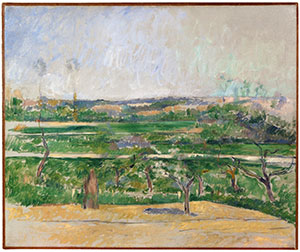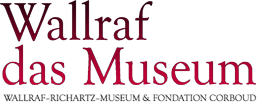Brief Report
This picture of a Provençal landscape in green, ochre and brownish-violet tones was acquired direct from the artist [Rewald 1996, Vollard Photo Archive no. 333] by Ambroise Vollard, who organized the first major Cézanne exhibition in 1895. Not only the numerous trees in the foreground, of which only the trunks were painted, but also the extent of the exposed grey ground, draw attention to the fact that this painting was abandoned by Cézanne at an early stage and, as a painting, is to be regarded as unfinished. The demarcation between paint applications and ground is particularly easy to see under UV radiation (fig. 4). For the majority of his works in the 1870s and 80s Cézanne used tinted grounds, for example in crème, ton clair, gris or écru [Callen 2000, p. 81] and Rewald thinks he recognizes the same grey ground in a further work by Cézanne dating from the same year [Rewald 1996, no. 409, vol. 1, p. 271]. Unfinished paintings often allow a very direct insight into the work of an artist, and in Cézanne’s work and life the unfinished almost became the characteristic feature of his work [exhib. cat. Cézanne, Vollendet Unvollendet, 1999]. In this work, therefore, we have a good opportunity of following the individual work phases. He prepared the composition very precisely on the loosely woven, pre-primed canvas (fig. 6) in the standard F10 size with an extensive and detailed underdrawing, as we often see in his work at this period. He used a lead or graphite pencil to sketch all the important elements of the picture. Next he went over all the contours with a thin brush in with a brownish-grey and blue wash to secure the motif, accentuating further details (figs. 5, 8). The few, exclusively wet-in-wet paint applications suggest that the painterly execution was completed in a single session. Cézanne started by increasingly covering the whole area of the picture both with thin, block-like applications of paint and demarcating these with a hatching, frequently diagonal, of fine brush-strokes (figs. 9, 11). It is worthwhile comparing this painting with the more finished Landscape to the West of Aix-en-Provence (WRM 3188), a further Cézanne in the Wallraf collection, and one with a similar motif, which was painted eight years later.
Paul Cézanne
born on 19 January 1839 in Aix-en-Provence,
died on 22 October 1906 ibidem
Further illustrations:
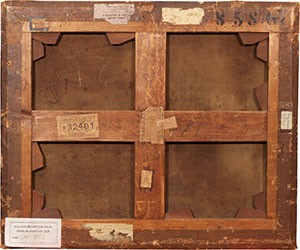
Fig. 02
Verso, lined

Fig. 03
Raking light

Fig. 04
UV fluorescence
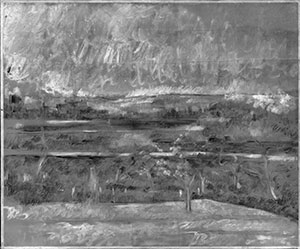
Fig. 05
IR reflectogram
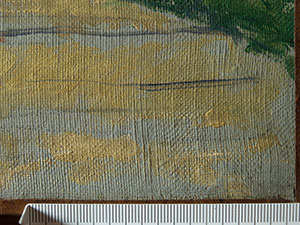
Fig. 06
Detail of the bottom right-hand corner, raking light, netlike canvas structure

Fig. 07
Grey ground, easily recognizable pigmentation and dominant craquelure, microscopic photograph (M = 1 mm)
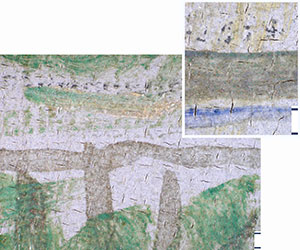
Fig. 08
Multistage underdrawing in pencil (lead or graphite) followed by dilute paint, microscopic photograph (M = 1 mm)
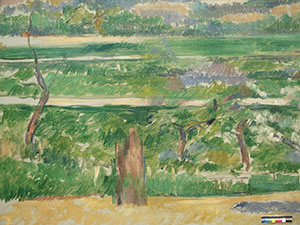
Fig. 09
Foreground with first lay-in in paint of the tree-trunks
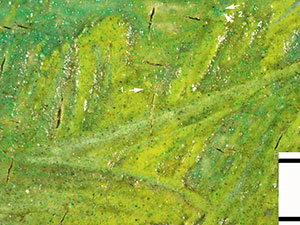
Fig. 10
Mixed-green paintlayer with two different pigmentations;
VIS spectrometry clearly suggests a copper-based green (1) and viridian (2), microscopic photograph (M = 1 mm)

Fig. 11
Applications of green with varying brushwork, dense dashes and with diagonal brush movements, microscopic photograph (M = 1 mm)
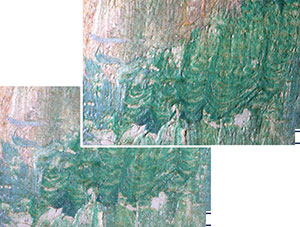
Fig. 12
Arc-like brush-strokes in echelon in incident and moderate raking light, microscopic photograph (M = 1 mm)

